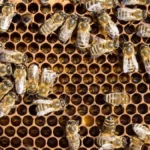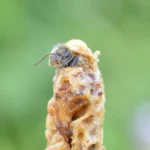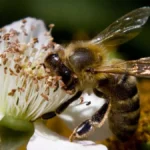In this article, we have a look at how to find the queen bee in a hive. To get this right you first need to be pretty sure you know what a queen bee looks like. To spot the queen bee is easy if you know how. We will now help you learn how to find the queen bee.
A beehive consists of anywhere from 2000 workers and a queen to anywhere above 50-60 000 worker bees in a large hive. Some hives have been recorded which have way more than 60 000 bees. Finding a queen in a big hive can be a bit daunting.
How The Human Brain Sees Masses Of Things
Our brains are optimized to see things that are different. So if you are looking for a specific apple in a heap of apples, you will struggle to find the one you are looking for. If however, you are looking for a banana in a heap of apples, you are looking for things that are not apples.
When we look at frames and heaps of bees you just have to trick your brain and look for “not a bee” and the queen will appear. But let us first go into what the queen looks like. If you know what she looks like, you will know then you see her.
What Does A Queen Bee Look Like?
The queen is like a bee on steroids – which is pretty much the truth. As a young bee, she got better food, rich in steroidal substances, and the result is that she has a huge abdomen that allows her to lay thousands of eggs per day.
The queen bee looks like this:

Read more about:Â How Long Can A Hive Be Queenless?
How To Find The Queen Bee
Now that we know what the queen looks like, let us explore how to spot the queen bee.
In a beehive, if you open the hive and move to the brood nest, this is where the queen should be. More often than not, she will be on frames that have open cells as she needs to lay eggs there. So these will be in the brood nest, and they will not be capped brood.
The trick is to move the frames out gently so that bees do no fall off – you do not want to have the queen running around inside the box on the bottom board. This is a difficult place to find her.
Hold the comb carefully and look in the light. You just scan over the frame and look for bees. The queen looks different and as soon as you see her she will jump out in your vision and you can normally watch her going about her business – walking from cell to cell and laying eggs.
A Sneaky New Method To Find The Queen
As AI technology advances, object recognition software and algorithms have matured to the point where you can actually use your cellphone to find the queen here. Well if you have an Andriod phone that is.
How To Make It Easier To Find The Queen
I once had a summer job where I had to open 50 hives every day, find the queens, and weigh them. In those days, technologies like this were not available yet. We marked the queens with stick-on labels. Basically, if you mark a queen with a label, or a bee marker pen, the bright color on her thorax makes it much easier to find her. If you order queens from a breeder you can also often ask for the queen to be marked.

How To Find The Queen In A Difficult Hive
Every now and then you can get a hive where you just cannot find the queen. I found that the easiest way to find her, in this case, is to attach a queen excluder to the base of a brood box. Place a super below the brood box and a bottom board under this. Take each frame of brood out and dump the bees in the empty brood box.
Once you have removed all the brood and combs from the box, shake all the bees in the box into the empty brood box. Place all the combs back in the box – quickly scan them for the queen – she can stick to the combs and resist shaking. Put the brood box back on the bottom board, place the super on top of the brood box, and the empty brood box with the queen excluder on top of this. Replace the lid on the top.
Come back half an hour later and all the bees should have moved back down to the brood box. You will most likely find the queen trying frantically to get through the queen excluder to get back down to the brood.
What Can Go Wrong
Queen Flies Away
Queen bees can sometimes be quite skittish and can fly up and out of the hive when disturbed. I have had a queen fly out of the hive and land behind my ear – I knew she was there because she was piping. Once you hear this sound for the first time you will know what you heard. It is literally the voice of the queen.
In some cases, if the queen flies a bit further, the bees will eventually find her and you will see a cluster of bees develop around her on the ground, or bush, or back of your head, or wherever it was that she landed. Gently lift the ball of bees up and return it to the hive.
Workers Ball The Queen
Sometimes touching the queen can trigger a response where the workers decide to kill her. When this happens the bees form a ball around the queen and try, and sometimes succeed, in stinging her to death. If this happens, you will need to replace the queen or let the hive rear a new queen.
We hope this article helped you learn how to find the queen. Finding a queen bee is an amazing experience – and hearing her pip is even more awesome. Please also try the app, and share with friends.
Read more about: How To Split A Beehive Without A Queen
Finding a Queen Bee FAQs
Why is it important to find the queen bee in a hive?
Finding the queen is essential because her presence ensures the colony’s health and productivity. A missing or injured queen can result in a colony’s decline or aggression.
What does a queen bee look like compared to worker bees?
The queen bee is larger, with a longer, more pronounced abdomen. Her thorax is broader, and she has a smooth, shiny appearance due to fewer body hairs. She also moves more slowly and deliberately than worker bees.
Where is the best place to look for the queen bee in a hive?
Start by inspecting the brood nest, as queens are often found laying eggs in open cells there. Look for uncapped brood combs, where she is most likely to be present.
Can I mark the queen bee to make it easier to find her?
Yes, many beekeepers mark the queen with a dot of non-toxic paint or a small sticker on her thorax. This makes her easier to identify in a hive filled with thousands of bees.
What is the ‘queen piping’ sound, and why is it important?
Queen piping is a distinctive noise made by a queen bee, often when disturbed or during a clash with a rival queen. It’s a valuable auditory cue that can help beekeepers locate the queen.
What can I do if I cannot find the queen bee?
If you’re struggling to find the queen, try using a queen excluder method. Shake the bees into a box with an excluder on top, which will trap the queen when she attempts to pass through, making her easier to spot.
What happens if the queen bee flies away during inspection?
If the queen flies away, the worker bees will likely gather around her, creating a ball of bees either on the ground or a nearby surface. Be patient and gently return her to the hive.
Can worker bees kill the queen, and what should I do if this happens?
Yes, worker bees may “ball” the queen if they perceive her as a threat or no longer viable. If this occurs, you’ll need to replace the queen or allow the colony to rear a new one.
What role does artificial intelligence play in finding the queen bee?
Advanced AI technology, including object recognition apps, can assist beekeepers in identifying the queen by scanning frames of bees. This technology is especially useful in larger hives.
How can I make it easier to find the queen in a large or aggressive hive?
In difficult hives, you can reduce the bee population by shaking the bees into an empty brood box with a queen excluder. This method isolates the queen, making her easier to find when workers return to the brood.

Dr. Garth A. Cambray is a Canadian/South African entrepreneur and beekeeper with 28 years of experience in apiculture and specializes in adding value to honey. His Ph.D. research developed a new advanced continuous fermentation method for making mead that has resulted in a number of companies globally being able to access markets for mead. His company, Makana Meadery, exports honey mead to the USA where it is available to discerning connoisseurs. He has also developed technologies to commercially manufacture organic honey vinegar in Zambia for export globally. He holds a few patents globally in the ethanol industry and believes in technology and knowledge transfer for human development and environmental sustainability. One of his proudest achievements is the fact that the wind farm he started at one of his old apiary sites has essentially made his hometown carbon neutral.






